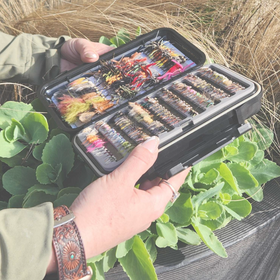The wet fly swing sounds like something one does at the square dance hall. Instead the wet fly swing is one of the oldest fly fishing techniques. It is used for all types of fish, where ever there is a current. Winter steelhead, salmon, big trout in big rivers, and even striped bass, are all prey that often require the use of the’ wet-fly swing’.
When to use it
The wet fly swing is designed to get the fly down deep quickly and swing it in front of the desired fish. Trout anglers use it when fish are holding deep, and not rising for any particular hatch. Winter steelheaders use it when steelhead loathe to move in the cold water and sit in between the feeding lanes or lie in the pocket water. Striped bass anglers find the wet fly swing works when using baitfish imitations in the current, to give them a lifelike presentation, that fool fish again and again.
The wet fly swing is most often used with streamers, like the Woolly Bugger or Muddler Minnow and sometimes wet flies, like soft hackles or traditional wet fly patterns. It is used whenever the fly fisher wants his presentation to appear to be swimming freely in the current. Preferably broadside to the current, while the fish will be waiting either in pocket water behind big rocks, or in a seam where the current changes speed. It can also be used in tailouts below pools.
Rigging
Most fly fishing anglers will use the wet fly swing with a sinking tip line. The weight will depend on the species of fish and the size of the water. Steelheaders and salmon anglers will be using 8-9 weight or above, and it goes on down for the other game fish. The point is you will want to rig fairly big, as you will not only be fighting the fish, but the current as well, and often times current that is deep. The leaders tend to be shorter than average, as you want the fly to follow sinking tip line, and not rise up in the current. As the take will be deep, you don’t want to have to set the hook with a lot of slack leader.
Depth is of importance, as this technique is generally used for fish lying deep. If you aren’t getting the depth you want, than try adding more weight, a larger fly, or switching lines. I try to avoid a sinking line, as I like the line to lie on the water, for ease of control, casting, and of course, setting that hook.
The Technique
The wet fly swing at its simplest is this. Find the water you want, and cast across stream, to slightly downstream. Mend your line immediately, usually upstream. This allows the fly to sink. Then follow your line with your rod tip downstream. Lowering your rod tip as the fly swings across the current, so the fly will not have any drag. Some anglers like to impart action on their presentation with their rod tip, but if fishing in current the action is often done all by itself.
When the fly has reached the end of its swing. Lift the line up, by doing a small roll cast, and then cast it out again. For deeper presentation, cast further upstream, for shallower presentation cast more downstream. If floating lines are what you are used to, casting the sinking tip line or even a shooting head line can take a little practice. Slowing down the entire casting stroke will be required, and allow the back cast to fully extend. But with a little practice, distance can be greatly improved allowing the fly fisher to reach water, unreachable by using other fly fishing techniques.
The wet fly swing is great for extending the season of fly fishing. When most other techniques prove to be ineffective, due to high or cold water. One can still entice those hesitant fish using this time tested technique.
Casting accuracy becomes most important when using Wet Flies, like Adams wet fly, and blue wing olive wet fly, simply because fish are not going to exert as much energy to consume a lower caloric food. If inexperienced try this technique with streamers mentioned above or your streamers of choice.Edited 12/27/16




